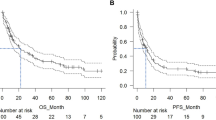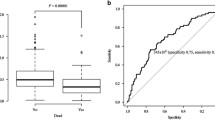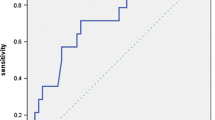Abstract
To investigate whether the post-therapy lymphocyte/monocyte ratio (ALC/AMC ratio or LMR) predicts early relapse in patients with diffuse large B cell lymphoma (DLBCL), we enrolled 125 consecutive patients with DLBCL and followed up from 2005 to 2015 in our hospital. The LMR was measured following completion of first-line therapy. We found that the LMR following completion therapy was a strong predictor of early relapse, which is less than 12 months after diagnosis. A low LMR was significantly associated with early relapse in both univariate [odds ratio (OR) = 8.8; P = 0.006] and multivariate analysis (OR = 8.951; P = 0.011). The low-LMR group (<2.9) had poorer outcomes than the high-LMR group (≥2.9), with a lower 2-year progression-free survival rate (78.9 versus 97.1 %, P = 0.002) and 2-year OS rate (82.5 versus 98.5 %, P = 0.002). This study suggests that a lower LMR following completion of first-line therapy can be used as a marker to predict early relapse in patients with DLBCL.

Similar content being viewed by others
References
Pfreundschuh M, Kuhnt E, Trumper L et al (2011) CHOP-like chemotherapy with or without rituximab in young patients with good-prognosis diffuse large-B-cell lymphoma: 6-year results of an open-label randomised study of the MabThera International Trial (MInT) Group. Lancet Oncol 12:1013–1022
Friedberg JW (2011) Relapsed/refractory diffuse large B-cell lymphoma. Hematology Am Soc Hematol Educ Program 2011:498–505
Gisselbrecht C, Glass B, Mounier N et al (2010) Salvage regimens with autologous transplantation for relapsed large B-cell lymphoma in the rituximab era. J Clin Oncol 28:4184–4190
Weeks JC, Yeap BY, Canellos GP, Shipp MA (1991) Value of follow-up procedures in patients with large-cell lymphoma who achieve a complete remission. J Clin Oncol 9:1196–1203
Oki Y, Kato H, Matsuo K et al (2008) Prognostic value of serum soluble interleukin-2 receptor level in patients with diffuse large B cell lymphoma, treated with CHOP- or RCHOP-based therapy. Leuk Lymphoma 49:1345–1351
Morito T, Fujihara M, Asaoku H et al (2009) Serum soluble interleukin-2 receptor level and immunophenotype are prognostic factors for patients with diffuse large B-cell lymphoma. Cancer Sci 100:1255–1260
Yamauchi T, Matsuda Y, Takai M et al (2012) Early relapse is associated with high serum soluble interleukin-2 receptor after the sixth cycle of R-CHOP chemotherapy in patients with advanced diffuse large B-cell lymphoma. Anticancer Res 32:5051–5057
Cheson BD, Pfistner B, Juweid ME et al (2007) Revised response criteria for malignant lymphoma. J Clin Oncol 25:579–586
Schouten HC (2007) Response evaluation and long-term follow-up. Ann Oncol 18(Suppl 1):i33–i36
Porrata LF, Rsitow K, Inwards DJ et al (2010) Lymphopenia assessed during routine follow-up after immunochemotherapy (R-CHOP) is a risk factor for predicting relapse in patients with diffuse large B-cell lymphoma. Leukemia 24:1343–1349
Oki Y, Yamamoto K, Kato H et al (2008) Low absolute lymphocyte count is a poor prognostic marker in patients with diffuse large B-cell lymphoma and suggests patients’ survival benefit from rituximab. Eur J Haematol 81:448–453
Feng J, Wang Z, Guo X et al (2012) Prognostic significance of absolute lymphocyte count at diagnosis of diffuse large B-cell lymphoma: a meta-analysis. Int J Hematol 95:143–148
Tadmor T, Bari A, Sacchi S et al (2014) Monocyte count at diagnosis is a prognostic parameter in diffuse large B-cell lymphoma: results from a large multicenter study involving 1191 patients in the pre- and post-rituximab era. Haematologica 99:125–130
Li ZM, Huang JJ, Xia Y et al (2012) Blood lymphocyte-to-monocyte ratio identifies high-risk patients in diffuse large B-cell lymphoma treated with R-CHOP. PLoS One 7:e41658
Lin B, Chen C, Qian Y, Feng J (2015) Prognostic role of peripheral blood lymphocyte/monocyte ratio at diagnosis in diffuse large B-cell lymphoma: a meta-analysis. Leuk Lymphoma 56:1–6
Belotti A, Doni E, Bolis S et al (2015) Peripheral blood lymphocyte/monocyte ratio predicts outcome in follicular lymphoma and in diffuse large B-cell lymphoma patients in the rituximab era. Clin Lymphoma Myeloma Leuk 15:208–213
Markovic O, Popovic L, Marisavljevic D et al (2014) Comparison of prognostic impact of absolute lymphocyte count, absolute monocyte count, absolute lymphocyte count/absolute monocyte count prognostic score and ratio in patients with diffuse large B cell lymphoma. Eur J Intern Med 25:296–302
Porrata LF, Ristow KM, Habermann TM et al (2014) Peripheral blood absolute lymphocyte/monocyte ratio during rituximab, cyclophosphamide, doxorubicin, vincristine and prednisone treatment cycles predicts clinical outcomes in diffuse large B-cell lymphoma. Leuk Lymphoma 55:2728–2738
Yan-Li L, Kang-Sheng G, Yue-Yin P et al (2014) The lower peripheral blood lymphocyte/monocyte ratio assessed during routine follow-up after standard first-line chemotherapy is a risk factor for predicting relapse in patients with diffuse large B-cell lymphoma. Leuk Res 38:323–328
Cheson BD, Horning SJ, Coiffier B et al (1999) Report of an international workshop to standardize response criteria for non-Hodgkin’s lymphomas. NCI Sponsored International Working Group. J Clin Oncol 17:1244
Hong J, Kim JH, Lee KH et al (2014) Symptom-oriented clinical detection versus routine imaging as a monitoring policy of relapse in patients with diffuse large B-cell lymphoma. Leuk Lymphoma 55:2312–2318
El-Sharkawi D, Basu S, Ocampo C et al (2012) Elevated lactate dehydrogenase levels detected during routine follow-up do not predict relapse in patients with diffuse large B-cell lymphoma who achieve complete remission after primary treatment with rituximab, cyclophosphamide, doxorubicin, vincristine and prednisone-like immunochemotherapy. Leuk Lymphoma 53:1949–1952
Kim DH, Baek JH, Chae YS et al (2007) Absolute lymphocyte counts predicts response to chemotherapy and survival in diffuse large B-cell lymphoma. Leukemia 21:2227–2230
Cox MC, Nofroni I, Ruco L et al (2008) Low absolute lymphocyte count is a poor prognostic factor in diffuse-large-B-cell-lymphoma. Leuk Lymphoma 49:1745–1751
Weiner GJ (2010) Rituximab: mechanism of action. Semin Hematol 47:115–123
Gabrilovich DI, Nagaraj S (2009) Myeloid-derived suppressor cells as regulators of the immune system. Nat Rev Immunol 9:162–174
Wilcox RA, Ristow K, Habermann TM et al (2011) The absolute monocyte and lymphocyte prognostic score predicts survival and identifies high-risk patients in diffuse large-B-cell lymphoma. Leukemia 25:1502–1509
Batty N, Ghonimi E, Feng L et al (2013) The absolute monocyte and lymphocyte prognostic index for patients with diffuse large B-cell lymphoma who receive R-CHOP. Clin Lymphoma Myeloma Leuk 13:15–18
Rambaldi A, Boschini C, Gritti G et al (2013) The lymphocyte to monocyte ratio improves the IPI-risk definition of diffuse large B-cell lymphoma when rituximab is added to chemotherapy. Am J Hematol 88:1062–1067
Li YL, Pan YY, Jiao Y et al (2014) Peripheral blood lymphocyte/monocyte ratio predicts outcome for patients with diffuse large B cell lymphoma after standard first-line regimens. Ann Hematol 93:617–626
Li YL, Gu KS, Pan YY et al (2014) Peripheral blood lymphocyte/monocyte ratio at the time of first relapse predicts outcome for patients with relapsed or primary refractory diffuse large B-cell lymphoma. BMC Cancer 14:341
Porrata LF, Ristow KM, Habermann TM et al (2013) Peripheral blood absolute lymphocyte/monocyte ratio recovery during ABVD treatment cycles predicts clinical outcomes in classical Hodgkin lymphoma. Blood Cancer J 3:e110
Acknowledgments
The English in this document has been checked by at least two professional editors, both native speakers of English. For a certificate, please see: http://www.textcheck.com/certificate/upCvUu
Author information
Authors and Affiliations
Corresponding author
Ethics declarations
From June 2005 until February 2015, 125 patients with DLBCL qualified for the study, which was approved by the Institutional Review Board of the First Affiliated Hospital of Wenzhou Medical University and performed in accordance with the principles of the Declaration of Helsinki.
Conflict of interest
The authors declare that they have no conflict of interest.
Rights and permissions
About this article
Cite this article
Zhou, SJ., Ma, YY., Zhang, Y. et al. Peripheral blood lymphocyte/monocyte ratio following completion of first-line therapy predicts early relapse in patients with diffuse large B cell lymphoma. Ann Hematol 96, 237–243 (2017). https://doi.org/10.1007/s00277-016-2865-x
Received:
Accepted:
Published:
Issue Date:
DOI: https://doi.org/10.1007/s00277-016-2865-x




